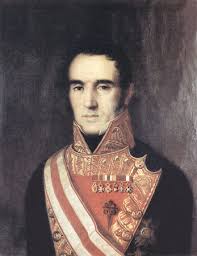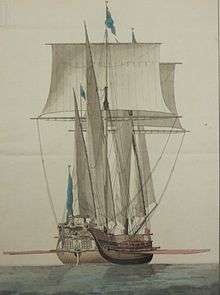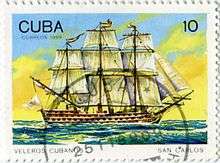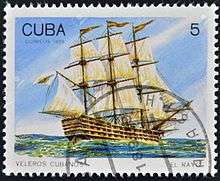Enrique MacDonell
| Minister of the Supreme Council of the Admiralty Enrique MacDonnell | |
|---|---|
 Portrait of Enrique MacDonnell | |
| Born |
1753 Pontevedra, Spain |
| Died |
23 November 1823 Cadiz, Spain |
| Allegiance |
|
| Service/ |
|
| Years of service | 1776 – 1823 |
| Rank | Vice-Admiral |
| Commands held | Santa Ana, Andaluz, Diligencia, Santo Domingo, Oden,San Felipe Apolstol. Astudo, Gallardo, SanCarlos, San Nicholas de Bari, Rayo |
| Battles/wars | |
Enrique MacDonell, also spelled MacDonnell, was an Irish-Spanish navy admiral [1] noted for his participation in several sea battles including the Battle of Trafalgar.
He was born in Pontevedra in Spain,[2] into a prominent Irish-Spanish family, though his naval records state his origin as Irish. His father was a Spanish Army brigadier-general and colonel of the Irish Regiment of Irlanda, and his mother a lady-in-waiting to the royal household.[3]
Spelling of surname
His surname is often incorrectly spelt MacDonell. It is actually signed MacDonnell in his letters and reports to the admiralty.
Irish family origins
In the Central Archive of the Spanish Armada' he is listed as an Irish citizen. This is incorrect as his baptismal certificate proves he was born in Spain. Few details exists of his youth but his family had Irish origins and kept strong Irish connections.[4][5] His grandfather was born in Dublin and his Grandmother from Cork and they fled to Spain to escape from religious persecution in Ireland.[4][5]
Army career
His immediate family had several generals in the Spanish Army and following that tradition he entered the Spanish Army to serve as a second-lieutenant in his father's regiment the Irish Ultonia in 1760 aged 7, and in January 1764 he is made 2nd lieutenant. He was swiftly promoted to Infantry lieutenant in 1769 and then advanced to the rank of captain in 1774, before requesting a transfer to the Spanish Navy.[3][6] In 1775 he is named a Knight of the Order of Santiago.[7]
Naval career

MacDonnell had a distinguished career in the navy, that saw him travel extensively and saw him in command positions in several famous battles including the battles of Roatan and Trafalgar. He was injured on several occasions but enjoyed a steady progression up through the ranks from Sub-Lieutenant to Vice-Admiral.
Naval Timeline
1776: In July, he joined the Spanish Navy as a Sub-Lieutenant and was assigned to a frigate ship Gaviota on an Algerian mission in the squadron of Captain Felix de Tejada. In September, he was transferred within this squadron to the 34 gun frigate Carmen. In November the Carmen and its support ships fought and burned two Ottoman Algeria xebecs in Melilla cove.[8][5]
1777: On 28 February, he was promoted to Lieutenant, and in April his next posting was Lieutenant in command of a xebec named Pilar bound for Corsica in the Mediterranean and the West Indies. During this time he was injured in a sea battle with a larger English ship before returning to Cadiz, and briefly being assigned to the ships San Isidro and Andoluz in December 1778.[5]
1779: In February, on recovery from his injuries with the rank of Lieutenant, he was posted to the 34 gun frigate Santa Maria Magdalena (1773). It was part of a six ship squadron patrolling the Azores seeking a squadron of 4-5 English ships traveling from South America to attack.They never made this interception but on 11 September the squadron spotted a lone English ship off Terceira Island in the Azores, the Magdalena and another frigate gave chase, but the English ship escaped as nightfall came. Because of this the frigates got separated from the fleet and sailed back towards Spain alone.[9][10] On 15 August 1779, the Magdalena captured the British 10 gun privateer Duke Of Cornwall off Cape St Vincent by disguising the Magdalena as a merchant ship by hiding the cannons. The privateer surrendered after the first Spanish warning salvo.
1780: On board the 30gun ship 'Andaluz' as part of a convoy to Havana, led by Don Jose De Solano transporting troops from the Hibernia regiment to Cuba, arriving in August 1780.
1781: In April, he boarded the 74 gun ship San Gabriel' '(1772), and participated in the Siege of Pensacola, where he went ashore with a detachment of marines and was wounded in action. Once recovered, on 4 August he was promoted and he received the command of the sloop Santa Ana, with the rank of Commander (Captain de Frigata) .[11]
1782: In March, he was one of the commanding officers in the Battle of Roatan. He is recorded in Spanish Naval Gazettes as being in command of one of the frigates. Elsewhere, his role has been described as a dual role, as the second-in-command on the 40 gun Santa Matilde (1778) but also as captain of one of the accompanying frigates.[12][13][14] When the British garrison refused to surrender, MacDonnell who spoke fluent English and French. was chosen to row ashore to offer terms of surrender, which were rejected. The Spanish stormed the island and took control after a short but fierce battle. The British surrendered on 17 March and its garrison of 81 soldiers were taken on board the Spanish ships as prisoners.[15][16] On 26 May, he took command of a private class sloop Santa Ana and transferred 400 soldiers from Trujillo, Colón, to the River Tinto in Honduras and other British settlements along that coast, helping to take possession of them. He left the Santa Ana and returned to Trujillo and was back onto the Santa Matilde. He moved to Havana and he took in command of the chambequin xebec Andaluz and he was promoted to full navy Captain on June 23, 1782.[5]
1783: In February, he took command of the corvette Diligencia (1781). On November 25, it left Havana en route to Spain. On 4 December, it engaged in a fierce battle against a superiorly armed English privateer ship, north of Bermuda, sinking it. the Diligencia travelled onwards to Cadiz, Spain [2][5]
1784: He was in the admiralty in Madrid for first nine months of the year before taking a brief command of the 74 gun Santo Domingo (1769) and sailing it to Ferrol to be decommissioned.[17]
July 1787 - May 1789: He returned to Cadiz and was appointed to the position of Port Captain in autumn 1878 briefly, and reappointed from May 1788 to March 1789. Whilst based in Cadiz he applied to join for the Swedish Navy after firstly securing permission to do so from the Spanish Navy.[4]
1789: During the summer of 1789 he joined the Swedish Navy to take part in the Russo-Swedish War (1788–1790) and was assigned command of the hemmema Oden with Måns von Rosenstein . During the Battle of Svensksund (1789) he had a ten-and-a-half-hour cannonade battle with several Russian ships at the Battle of Svensksund (1789) . He eventually surrendered after becoming surrounded by seven ships. and having already lost one-third of his crew and with only four cannons still operating. along with many of his crew he was badly injured himself. He was taken a prisoner of war in St Petersburg. Upon his release he was awarded military honours by Gustav III of Sweden. He was reportedly offered the supreme command of the entire Swedish Navy with 35 ships and 20,000 sailors. He declined the position as a condition of his early release from Russia was that he would not go to war with Russia again. Correspondence with the King of Spain approved his decision to decline the offer.[18][4] He did remain as a naval advisor to the king sitting on his war council.[5]
1791: In July, he returned to Spain, taking commandl of the 68/64 gun San Felipe Apostol ship (1781) conducting operations off the coast of Morocco until December.[5]
1793: He was in Captain of the 60 gun Astuto (1759) ship from '5 May to 31 August, and sailed with the a fleet of 24 ships under the command of Don Francisco De Borja, on the Campaign of Sardinia. The fleet succeeded in the Capture of San Pietro and Sant'Antioco, islands. Heavily outnumbered the French garrison of 800 men and 400 sailors surrendered without a battle, and the 36 gun frigate French frigate Hélène (1791) was captured.[19]
1793: August 1793 until January 1794, he was Captain on the ship 74 gun Gallardo (1754), with Adm. De Borja's fleet.[20]
1794: On 25 January, he was promoted to Commodore.(Brigadier) [5]
1794-1795: In August 1794, he was Commodore of the 94 gun San Carlos (1765). sailing from Cadiz it travelled to Havana and the Sea of the Antilles in the squadron of Amistizabal before leaving Havana in February 1795 with the ship Europa (1789) and both returning to Cadiz arriving in April 1795 laden with money, gold and goods.[21][22][23]
1795-1796: In May 1795 he was commodore of the 80 gun San Nicholas de Bari (1769)[24] '. It was a short command and In February 1796 he passed command of the San Nicholas to Commordore Tomas Geraldino who later died onboard during a battle with Horatio Nelson's ship HMS Captain in 1797 Battle of Cape St. Vincent [25] Geraldino and MacDonnell were colleagues while living in Cadiz.
He changed ship to Angel de la Guarda and returned to Havana, during this time he was brought before his superiors following a dispute with a lieutenant. Fernando Morillo, with the case being dismissed, before once again returning to Spain in 1799.
1799: He was made a Commander de Palmoas en la Order Santiago[26]
1800: In Spain.
1801: He retired from the navy with the honorary use of his uniform and rank.[5]
1804: He wrote the 'Coordinated offensive plan of land and sea against the United States of America'. In was submitted to Minister Dom Grandallana, returned apparently unread or uncommented upon. The plan submitted to the Spanish Admiralty for a full-scale war and invasion of the United States of America, involving naval and ground battles. Spain was becoming increasingly concerned at the growth of American power. The Third Coalition and the 1808 French destruction of the Spanish naval fleet saw this plan withdrawn.[27] [5]
1805: He came out of retirement.
1805: He rejoined the navy and fought at Battle of Trafalgar commanding the 100 gun Spanish ship Rayo (1751). After the battle he led a daring rescue mission of to recapture Spanish and France ships taken during the battle. This rescue freed four ships and 3000 prisoners including Vice-Admiral Álava. This sortie also captured 150 English sailors and that enabled the Spanish and French to negotiate a prisoner swap days later. He was promoted to Rear-Admiral the following fortnight on 8 November.[28]
1808: After the Spanish insurrection of Seville, and the beginning of Spanish war of independence, the Spanish junta in Cadiz rose up against the French. He was appointed by the Supreme Junta of the city as commander of the Spanish fleet. His first task was to sail out to the British fleet under Admiral Collingwood to declare they were about to attack the French and to seek allegiance with Britain. He refused Collingwood's offer of assistance as this would have meant a sharing of the captured French ships after the attack that became known as the Capture of the Rosily Squadron. On his return he had orders to attack the French fleet in the port, assisting the ground cannons, with five days hostilities ongoing the Spanish refused the British offer of assistance as they watched from sea. The French surrendered. After taking the French ships he was to board the flagship of British admiral John Child Purvis, general commander of the squadron that blocked the city, trying to get the cease hostilities between Spain and Great Britain, a matter that was satisfactorily resolved with Admiral Collingwood also coming ashore to negotiate a new Spanish-British alliance. In this he was so successful that the English general Sir John Moore, offered to press for MacDonnell’s appointment as the Junta’s ambassador in London; but MacDonnell refused saying,'to have accepted a diplomatic post when there was a general call to arms in my country, would not have been in keeping with the dignity and character of a high-ranking officer”.
1815: He is admitted to the military hospital in Cadiz. ( June 1815 to June 1816 ).[7]
1817: He was promoted to Vice-Admiral and appointed a Minister of the Supreme Council of the Admiralty.[5] Vice-Admiral Álava, who, he helped rescue at Trafalgar, had also just been made an Admiral at the Admiralty at that time.
1818: The Supreme Council was abolished.
1820: He subdued a mutiny in Cadiz.
Battle of Trafalgar
In 1804, Federico Carlos Gravina y Nápoli was short of experienced officers and MacDonnell volunteered to come out of retirement. Both men wrote to the armada admiralty at the same time seeking his reappointment. MacDonnell offered to take any rank the navy considered suitable but he was reinstated as commodore. Gravina appointed him commodore of the Spanish ship Rayo (1751).
Before the battle itself, a war council meeting of the fourteen leading Franco-Spanish Admirals and Commodores was held on Pierre-Charles Villeneuve's ship in Cadiz port. MacDonnell, a French speaker, was chosen as one of the seven senior Spanish naval officers on the Spanish side. It was a meeting that got very argumentative with raised voices Trafalgar[29]
Despite Spanish warnings Pierre-Charles Villeneuve in command of the combined fleet decided to put to sea on 21 October. On leaving port the fleet encountered Nelson's fleet which attacked and began the Battle of Trafalgar. At the battle MacDonell was in command of the 100 gun Rayo that was positioned at the rearguard. Due to the weak wind conditions the Rayo initially found it difficult to turn to join the battle. Later MacDonnell ignored the orders of the French Commodore in charge or the rearguard, and was one of only two ships from the rearguard that turned back to join the centre of battle.
The Rayo had 4 deaths during the battle and its mast was seriously damaged. After the battle at sunset the Rayo escaped capture and MacDonnell was the highest ranking Spanish officer to escape the battle uninjured and return to Cadiz.
Trafalgar Rescue Sortie
On 22 Oct, the day after the battle, a council of war meeting of senior naval officers was held in Cadiz port where the surviving ships had harbored. At this meeting plans were made on the Spanish flag ship Principe de Asturias by Admiral Antonio de Escaño who reasoned that the English would find it hard to hold onto the captured ships because of the stormy weather. He ordered a rescue mission to recapture these ships which had thousands of Spanish and French prisoners on board. As the only senior officer remaining, MacDonnel was given command of the rescue squadron along with French commodore Julien Cosmao[30]
The following morning 23 October, at 9:30am the mission began and five ships, with support frigates, set out to sea. This mission was to have the appearance of a surprise counter-attack, but the recovery of ships was the objective. The orders were only engage in battle with ships of similar size if challenged and conditions favored. The English ships on the end of their fleet, were forced to un-tow four ships and form a defensive line. The rescue fleet took control of two of the freed ships and towed them to Cadiz, while two other ships rose up and overpowered the prize crews, and sailed away, but one later grounded on rocks with the crew rescued, and the other it transferred its crew to a supporting ship and it went down in that evening's storm. The storm was also to sink two of the original rescue ships were damaged and stranded at sea, including the Rayo.
The following day, the Rayo that was badly damaged by the storm, was crippled and was captured by HMS Donegal (1798) The British success in capturing Rayo was short lived as it too foundered shortly after the British prize crew took command. MacDonnell was taken prisoner aboard the Donegal.[31] The entire crew was rescued by Cadiz small craft and with prize crew taken prisoner.
The mission was considered a success despite the loss of two rescue ships. Two recaptured ships reached Cadiz safely. and the crew of a third ship were saved. Also, the crews of both rescue ships that sank were also saved.
Most importantly for the Spanish was the recapture of Vice-Admiral Álava's Santa Ana flag ship.
The rescue was a disappointing but unavoidable result for the British. They lost four captured ships, including the 350 cannon on board, and 3,000 prisoners, but crucially 150 of their own men manning the prize ships were captured by the rescue crews. The capture of the prize crews was to prove crucial and forced the British to stay at Trafalgar to negotiate a prisoner swap. MacDonnell who was on board the HMS Donegal was released in these negotiations a week after the battle. Prisoners on both sides were treated very humanly, especially officers. MacDonnell was able to write a full report to Admiral Gravina while onboard Donegal indicating he was afforded cordial treatment and facilities.[32]
Captured by HMS Donegal
At the time the Rayo was captured on October 25, all three of its masts were broken and it was unable to put up a defense fight. MacDonnell lowered the Spanish flag to surrender after the first cannon shot, and then threw the ship's secret signals book overboard tied to a cannonball. A prize crew from HMS Donegal including its Master took control of the near crippled Rayo, and MacDonnell was taken prisoner on board the Donegal. It coincidentally was the French frigate that Irish revolutionary Wolfe Tone was captured on off the coast of Ireland and it was renamed. Despite the efforts of the British prize crew Rayo was to flounder on the rocks in the storm with the loss of 25 lives. The remaining Rayo crew and 25 British sailors and officers on board were rescued by small Spanish boats. The Master of HMS Donegal recounted unexpected kindness when that he was not allowed disembark the small boat in Cadiz until a small cart was reversed into the water, to ensure he could step onto it and then ashore so not to get we. MacDonnell was equally well treated while on board the Donegal and he released after a week on board. While on that ship he wrote his report to the admiralty, after a week, Captain Henry Blackwood came ashore to Cadiz and both sides exchanged prisoners.
Rear Admiral
Trafalgar had an immediate impact on MacDonnell's career. In the weeks after the battle he was promoted to Rear-Admiral with his role in the Battle of Trafalgar and rescue of Vice Admiral Álava elevating his reputation. Álava would later be promoted to Admiral and at that time MacDonnell also became Vice-Admiral.[5]
Illness and Death
He returned to Cadiz, where he had to return to enter the hospital there due to illness . He died there on November 23, 1823. His funeral was paid by public subscription indicating a lack of personal funds.[2]
Popular culture
- The Rayo ship was featured on a Cuba stamp in 1989.
- The Spanish Navy named a ship "Rayo-P42' in 2011 [33]
- The remains of the Rayo ship were located in 2003 by a team from the University of Huelva, 300 meters from the shore and 7 meters deep. Little remains today because the deposit was plundered several times historically.
References
- ↑ Warner, Oliver (2003). Nelson's Battles: The Triumph of British Seapower. Barnsley: Pen and Sword. p. 175. ISBN 9781473816701.
- 1 2 3 http://diariodepontevedra.galiciae.com/blog/424331/el-pontevedres-que-combatio-en-trafalgar
- 1 2 "Don Enrique Reynaldo MacDonnell – Admiral of the Spanish Navy 1753-1823". Glens of Antrim Historical Society. 11 December 2005. Retrieved 22 February 2017.
- 1 2 3 4 http://antrimhistory.net/don-enrique-reynaldo-macdonnell-admiral-of-the-spanish-navy-1753-1823/
- 1 2 3 4 5 6 7 8 9 10 11 12 13 Nuestro Tiempo, Madrid, August 1908, Biography
- ↑ Clark, George B. (2010). Irish Soldiers in Europe, 17th-19th Century. Cork: Mercier Press. p. 40. ISBN 9781856356626.
- 1 2 http://ancienhistories.blogspot.ie/2017/08/enrique-macdonnell-y-gonde.html
- ↑ http://www.todoababor.es/datos_docum/hist_fr_n.htm
- ↑ archive of the Spanish armada admiralty
- ↑ http://threedecks.org/index.php?display_type=show_ship&id=13029
- ↑ Clark, George B. (2010). Irish Soldiers in Europe, 17th-19th Century. Cork: Mercier Press. p. 41. ISBN 9781856356626.
- ↑ https://books.google.ie/books?id=i3XRVI4dDMQC&pg=PA316&lpg=PA316&dq=enrique+Macdonell+santa+matilde&source=bl&ots=R1D83IqZ8z&sig=v-MFrdddGE7WxY20xb47M-sgvOA&hl=en&sa=X&ved=0ahUKEwje3JKSk7DSAhXLKMAKHb4eDfMQ6AEIJDAC#v=onepage&q=enrique%20Macdonell%20santa%20matilde&f=false
- ↑ https://books.google.ie/books?id=cCbhQZFdZlYC&pg=PA163&lpg=PA163&dq=enrique+macdonell+santa+matilde&source=bl&ots=i1KHzkhiqe&sig=PN-j_l8_07OP4zCU24bulZGapCI&hl=en&sa=X&ved=0ahUKEwjWnu3gk7DSAhXhDcAKHVc9CakQ6AEIJjAD#v=onepage&q=enrique%20macdonell%20santa%20matilde&f=false
- ↑ https://books.google.ie/books?id=esNFAAAAcAAJ&pg=RA1-PA38&lpg=RA1-PA38&dq=enrique+macdonell+roatan&source=bl&ots=-QJ8eEmMdH&sig=NpHseUOrvWjUGVMsLhFJN9rP2ks&hl=en&sa=X&ved=0ahUKEwjSovTemLDSAhWpB8AKHT4TAMwQ6AEIPzAJ#v=onepage&q=enrique%20macdonell%20roatan&f=false
- ↑ https://books.google.ie/books?id=cCbhQZFdZlYC&pg=PA163&lpg=PA163&dq=roatan+macdonell&source=bl&ots=i1KGGhipqg&sig=9InyDXb6Xp7TtHj6zqGVCntzIMk&hl=en&sa=X&ved=0ahUKEwjMi9LfzKbSAhWjJcAKHeLFDaoQ6AEIKjAC#v=onepage&q=roatan%20macdonell&f=false
- ↑ https://books.google.ie/books?id=iXChDAAAQBAJ&pg=PT110&lpg=PT110&dq=enrique+macdonell+penscola&source=bl&ots=cHMY5cT6E6&sig=1jkp-xWDkHJyBrNrYq8CeAb7NFQ&hl=en&sa=X&ved=0ahUKEwjkrJ2KyrDSAhVpK8AKHVyiDtMQ6AEILzAE#v=onepage&q=enrique%20macdonell%20penscola&f=false
- ↑ Nuestro Tiempo,Madrid - August !908, Biography
- ↑ George B. Clark, Irish Soldiers in Europe, 17th-19th Century, page 42, Google Books. Retrieved 25 February 2017.
- ↑ http://www.todoababor.es/listado/navio-astuto.htm
- ↑ http://3decks.pbworks.com/w/page/914990/HCMS%20Gallardo%20(1754)
- ↑ http://3decks.pbworks.com/w/page/915084/HCMS%20San%20Carlos%20%281765%29
- ↑ http://threedecks.org/index.php?display_type=show_ship&id=2665
- ↑ http://www.todoababor.es/listado/navio-sancarlos3.htm
- ↑ http://threedecks.org/index.php?display_type=show_ship&id=2654
- ↑ http://3decks.pbworks.com/w/page/915133/HCMS%20San%20Nicolas%20de%20Bari%20%281769%29
- ↑ https://books.google.ie/books?id=JhqIC09VeKEC&pg=PA9&lpg=PA9&dq=escano+macdonell&source=bl&ots=a7lzPUknSK&sig=Us_O8rPy-mkPlVkrOOwVY-T3_-g&hl=en&sa=X&ved=0ahUKEwiA3becpLPSAhUhKMAKHQJ-CxgQ6AEIRjAJ#v=onepage&q=escano%20macdonell&f=false
- ↑ "Spanish Naval Strategy and the United States, 1763–1819". The Mariner's Mirror. 101: 4–20. doi:10.1080/00253359.2015.994872.
- ↑ Clark, George B. (2010). Irish Soldiers in Europe, 17th-19th Century. Cork: Mercier Press. pp. 42–43. ISBN 9781856356626.
- ↑ id=X1xbTYBdw7EC&pg=PT297&lpg=PT297&dq=enrique+macdonnell&source=bl&ots=kHRwUdK9bE&sig=8yUn7iVHlTCWjbdrkBDh0xBkfAI&hl=en&sa=X&sqi=2&ved=0ahUKEwiskavSsqHSAhULIsAKHYOyBLwQ6AEIODAF#v=onepage&q=enrique%20macdonnell&f=false |others= |title=Nelson's Battles: The Triumph of British Seapower |origyear= |publisher=Pen and Sword |location=Barnsley |year= 2003|language= | ISBN 9781473816701 |page=179 |pages= |at=}}
- ↑ https://books.google.ie/books?id=X1xbTYBdw7EC&pg=PT297&lpg=PT297&dq=enrique+macdonnell&source=bl&ots=kHRwUdK9bE&sig=8yUn7iVHlTCWjbdrkBDh0xBkfAI&hl=en&sa=X&sqi=2&ved=0ahUKEwiskavSsqHSAhULIsAKHYOyBLwQ6AEIODAF#v=onepage&q=enrique%20macdonnell&f=false
- ↑ Craig, Phil; Clayton, Tim (2012). Trafalgar: The Men, the Battle, the Storm. London: Hachette UK. ISBN 9781444719772.
- ↑ James (Vol.IV) p.91
- ↑ Rayo (P-42)
His Biography on Antrim History website.
Images of ships he sailed on



